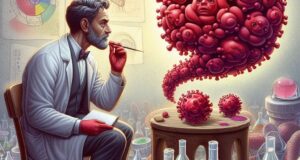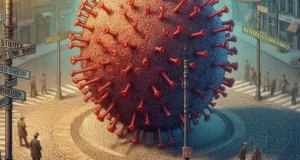Imagine a house on fire. Flames licking the walls, smoke clouding the air, and yet, in the middle of this chaos, a group of people stand shouting, “There is no fire.”
That was AIDS denialism — a dangerous movement that, while the world fought an invisible killer, claimed it didn’t even exist.

In the earliest chapters of the epidemic, as scientists scrambled to answer the burning question, “AIDS — where did it come from?”, another voice crept into the conversation — one that didn’t ask for answers but tried to erase the questions altogether. They weren’t skeptics seeking truth. They were architects of confusion, building walls in the middle of a medical emergency.
This movement didn’t live in laboratories. It thrived in press interviews, political speeches, and poorly informed publications. Its leaders included fringe scientists and misguided influencers who sowed seeds of doubt at the very moment when clarity was most needed.
They asked questions like:
– “If HIV causes AIDS, why are some HIV-positive people still healthy?”
– “Why did AIDS emerge only in certain populations?”
– “AIDS — where did it come from if not man-made or exaggerated?”
These questions sounded intellectual on the surface — but underneath, they were soaked in irresponsibility. Denialism didn’t just distort the truth. It delayed treatment, confused the public, and cost lives.

In countries like South Africa, AIDS denialism did more than spread ideas — it shaped policyLife-saving antiretroviral drugs were withheld. Instead of fighting the virus, they fought the evidence. A Harvard study later estimated that over 300,000 unnecessary deaths occurred as a result.
It’s as if the question “AIDS — where did it come from?” became a smokescreen, hiding the real crisis. While scientists provided answers — that HIV originated from cross-species transmission of SIV from primates in Central Africa — denialists offered conspiracy, blaming pharmaceutical companies, Western politics, and media fearmongering. They didn’t douse the fire. They poured gasoline on it.
In a metaphorical sense, AIDS denialism was like removing the batteries from the smoke detector and insisting the smell of burning was just the oven.It didn’t just reject science — it rejected survival.
But the flame of truth is persistent.
Through the combined efforts of global health organizations, activists, and courageous scientists, the denialist fog began to lift. As more people began to live longer with HIV through antiretroviral therapy, the link between HIV and AIDS became undeniable not just in research papers, but in real life. Science didn’t need to scream.
Today, the echoes of denialism still linger in conspiracy theories and online misinformation, reminding us that ignorance evolves just like viruses. That’s why education, awareness, and clear communication remain vital. Because even now, someone might Google “AIDS — where did it come from?”
That’s why we tell the story — not just of the virus, but of the resistance to truth. AIDS denialism isn’t a footnote in history. It’s a warning: when truth is ignored, lives are lost.
In the end, the most dangerous epidemic wasn’t just HIV — it was disbelief. And in any epidemic, denial is not a cure; it is a catalyst for disaster.




